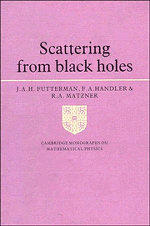Book contents
- Frontmatter
- Contents
- Acknowledgements
- Foreword
- 1 Introduction
- 2 Perturbations of black hole spacetimes
- 3 Integral spin plane waves in black hole spacetimes
- 4 Neutrino plane waves
- 5 Scattering
- 6 Limiting cross sections
- 7 Computation of cross sections
- 8 Absorption, phase shifts and cross sections for gravitational waves
- 9 Conclusion
- Appendix A1 Integrals used to express plane waves in terms of spin-weighted spheroidal functions
- Appendix A2 Addition formulae for spin-weighted spherical angular functions
- Appendix B
- References
- Index
2 - Perturbations of black hole spacetimes
Published online by Cambridge University Press: 04 August 2010
- Frontmatter
- Contents
- Acknowledgements
- Foreword
- 1 Introduction
- 2 Perturbations of black hole spacetimes
- 3 Integral spin plane waves in black hole spacetimes
- 4 Neutrino plane waves
- 5 Scattering
- 6 Limiting cross sections
- 7 Computation of cross sections
- 8 Absorption, phase shifts and cross sections for gravitational waves
- 9 Conclusion
- Appendix A1 Integrals used to express plane waves in terms of spin-weighted spheroidal functions
- Appendix A2 Addition formulae for spin-weighted spherical angular functions
- Appendix B
- References
- Index
Summary
The scattering problem divides naturally into two major parts: the perturbation solution and the asymptology. For a given spacetime, the scattering problem is obtained by defining standard ingoing and outgoing states in the asymptotic regions of the spacetime, solving the perturbation equations, and matching (by adjusting the complex constant coefficients of the solution) the perturbation solutions to the asymptotic forms. Asymptology refers to the detailed description and normalization of the ingoing and outgoing states; it is treated in chapters 3 and 4. In this chapter we treat the derivation of the equations governing perturbations of the Kerr geometry.
The first approach taken to obtain perturbation equations was by perturbing the metric directly (in Schwarzschild) and solving for the resulting perturbed field solutions (Regge & Wheeler, 1957). This approach is the most intuitively physical approach, dealing throughout with metric quantities having direct, physical interpretations and therefore immediate connection to such quantities of interest as wave amplitudes and energy fluxes. As would be expected, the equations involved are manifestly real; in particular the scattering potentials are real. We will see that the reality of the scattering potential is intimately related to the parity of the solutions, interpretations of the wave scattering amplitudes, and numerical convenience in integrating the radial equations.
However, the above considerations are secondary in considering metric perturbations for the Kerr geometry. In Schwarzschild, direct solution for metric perturbations is a formidable task. In Kerr, the solution is very much more difficult; Chandrasekhar (1983) has given a review of this approach. Here we will concentrate on a Riemann tensor approach, based on the NP techniques.
- Type
- Chapter
- Information
- Scattering from Black Holes , pp. 13 - 28Publisher: Cambridge University PressPrint publication year: 1988



